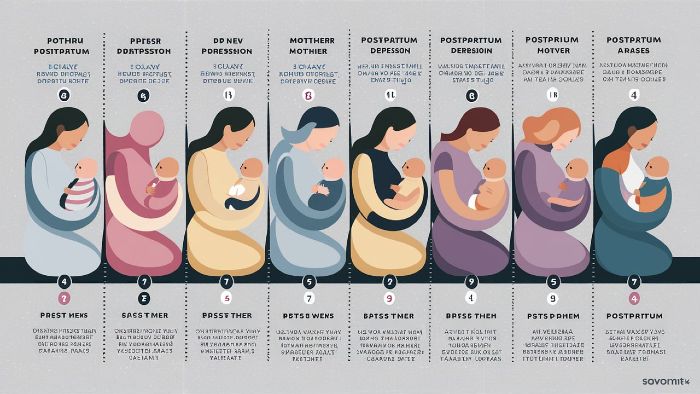In the dead of night, after the last feeding, when the house is finally still, you lie awake. The joy you were promised feels like a distant shore you can’t reach. Instead, you are adrift in a sea of sadness, anxiety, and exhaustion. And in that suffocating quiet, one question surfaces, desperate and raw: When will this end?
It is the most human question to ask when you are in pain. You’re not just asking for a date on a calendar; you’re asking for a finish line. You want to know when the sun will rise on your personal long night. You want to know when you will feel like “you” again.
The clinical answer is that the duration of postpartum depression (PPD) varies. But that’s not enough. You need a real answer, a realistic map of the journey ahead.
This guide is that map. We will walk through the typical timelines of recovery, the critical factors that can shorten or lengthen the journey, and what you can realistically expect as you navigate your way back to yourself. The most important landmark on this map is the one at the very end: PPD is temporary, and recovery is not just possible—it is expected.
[Insert a hopeful, compelling image here: a path leading out of a dark wood into the light, or a sunrise breaking over the horizon.]
First, Are You Sure It’s PPD? The Baby Blues vs. Depression
Before we can talk about the duration of PPD, we have to be sure that’s what we’re facing. The “baby blues” are extremely common, but they are very different from clinical postpartum depression.
| Feature | The “Baby Blues” | Postpartum Depression (PPD) |
|---|---|---|
| When It Starts | 2-3 days after delivery. | Can start anytime in the first year, often within 1-3 months. |
| How Long It Lasts | A few days up to two weeks. It resolves on its own. | More than two weeks. It often worsens without treatment. |
| What It Feels Like | Mood swings, weepiness, feeling overwhelmed. You still have moments of joy. | Persistent sadness, anxiety, guilt, numbness, loss of pleasure in everything. |
| Severity | Mild and manageable. Doesn’t stop you from caring for your baby. | Severe enough to interfere with your ability to function and care for yourself or your baby. |
| The Fix | Rest, support, and time. No medical intervention needed. | Requires professional treatment (therapy, medication, etc.) to resolve. |
Key Takeaway: If your symptoms have persisted for more than two weeks and are impacting your daily life, it’s time to stop calling it the “baby blues.” It is crucial to speak with a healthcare provider to explore the possibility of PPD.
The Recovery Timeline: What to Realistically Expect

If you are receiving effective treatment for PPD, your recovery will likely happen in phases. This is not a straight line—expect good days and bad days. The key is the overall upward trend.
Phase 1: The Onset and Seeking Help (First 1-3 Months Postpartum)
For many women, PPD symptoms emerge and intensify in the first three months. This period can be the most frightening and confusing. Hormones are still chaotic, sleep deprivation is at its peak, and the reality of 24/7 infant care is setting in.
This is often when the illness is at its most severe and when women or their families recognize that something is seriously wrong and seek help. This act of seeking help is the official start of the recovery timeline.
Phase 2: The Turning Point (Months 3-6)
With consistent, proper treatment, this period is often when the first real glimmers of light appear.
- If you’re on medication (like an SSRI): These medications typically take 4-8 weeks to become fully effective. By the 3-month mark, many women start to feel the “fog” begin to lift. The intense, crying lows become less frequent. You might start having more “okay” days than terrible ones.
- If you’re in therapy (like CBT): You’re starting to build your toolkit. You’re learning to identify and challenge negative thoughts. You’re practicing small “behavioral activation” steps. You’re starting to feel a flicker of agency over your own mind.
This is not a sudden cure. It’s a slow thaw. You’ll still have setbacks, but the overall trajectory is moving away from despair and toward stability.
Phase 3: Finding Your Footing (Months 6-12)
For many women in treatment, this is the period of consolidation. By the time their baby is approaching their first birthday, they often feel significantly better.
“Recovery” at this stage doesn’t mean you’re perpetually happy. It means:
- You feel like yourself again, most of the time.
- You can experience genuine joy and pleasure.
- You feel a secure bond with your child.
- You have the tools to manage a bad day without it spiraling into a depressive episode.
Treatment may continue during this phase to ensure stability. Doctors often recommend staying on an effective antidepressant for at least 6-12 months after you start feeling well to significantly reduce the risk of relapse.
The Big Question: What Factors Influence How Long PPD Lasts?
The “6 to 12 months” timeline is a general average for those in treatment. Your personal journey will be shaped by several critical factors. Understanding them can empower you to take control.
Factor 1: How Quickly You Get Help
This is the single most important variable. The longer PPD goes untreated, the more entrenched the negative thought patterns become, and the longer the road to recovery can be. An untreated infection gets worse; so does untreated depression. Early intervention is proven to shorten the duration and severity of the illness.
Factor 2: The Quality and Consistency of Your Treatment
Simply seeing a doctor isn’t the whole story.
- The Right Therapy: Finding a therapist who specializes in perinatal mental health can make a world of difference.
- The Right Medication: Sometimes it takes trying more than one antidepressant to find the one that works best for you.
- Consistency: Attending your therapy appointments and taking your medication as prescribed, every single day, is non-negotiable for a steady recovery.
Factor 3: The Strength of Your Support System
You cannot recover from PPD in a vacuum. A strong support system is like a medical intervention in itself.
- A Supportive Partner: A partner who educates themselves, takes on a larger share of the load without being asked, and provides emotional support is invaluable.
- A “Village”: Friends, family, or even paid help (like a postpartum doula) who can give you a break to sleep, shower, or just be alone are crucial. Isolation is fuel for depression.
Factor 4: Sleep, Sleep, and More Sleep
Chronic sleep deprivation has a profound and direct negative impact on brain function and mood. You cannot heal your brain if it never gets a chance to rest and repair. Prioritizing your sleep—by arranging shifts with your partner or accepting help from others—is not a luxury. It is a core component of your treatment.
A Story of Hope
“I was diagnosed when my daughter was 2 months old, and I was sure my life was over. The first few months of treatment felt like wading through mud. But around 5 months, I had a good day. Then a few good days in a row. My therapist called it ‘collecting evidence’ that I could feel better. By 9 months, I felt like I was back. The sadness was gone. It was a long, hard road, but every step was worth it. Please, just take the first step.”
— Jessica, a mom of one
Addressing the Fear: Can Postpartum Depression Last for Years?
This is a deep-seated fear for every suffering mother. The honest answer is that if left untreated, yes, postpartum depression can become a chronic depressive disorder.
Studies, including data from the World Health Organization (WHO), show that without intervention, a significant percentage of women with PPD still have symptoms years later.
This statistic is not meant to terrify you. It is meant to motivate you.
It powerfully illustrates that PPD is not something you can just “push through” or that will magically disappear on its own. Hope is not found in waiting; it is found in acting. If you are more than a year postpartum and still struggling, it is not too late. Effective treatment is still available and can help you recover.

Frequently Asked Questions (FAQ)
Q1: When does postpartum depression usually peak?
While it varies, PPD symptoms often peak around 3-4 months postpartum, especially if the person has not yet sought treatment. This is often the point of crisis that drives them to get help.
Q2: Will I be on medication forever?
Not necessarily. Many women, in consultation with their doctors, are able to successfully taper off their medication after being stable and symptom-free for 6-12 months. The coping skills learned in therapy, however, are for life.
Q3: If I had PPD with my first baby, how long will it last if I get it again?
Having PPD once means you’re more prepared the second time. Because you can recognize the signs earlier and begin treatment immediately, the duration of a subsequent episode may be significantly shorter and less severe.
What You Can Expect is a Sunrise
So, what should a mother expect for the duration of her postpartum depression?
Expect a journey, not an event. Expect that with prompt, consistent treatment, you will likely start to feel a real shift within 3-6 months and be on solid ground by the end of the first year. Expect setbacks, but also expect progress.
Think of recovery like a sunrise. For a long time, it’s just a faint, barely perceptible glow on the horizon. You might not even trust that it’s real. But slowly, gradually, and then all at once, the light begins to pour in, chasing away the long shadows of the night.
That new day will come for you. Hold on.
Disclaimer: This article is for informational purposes only and does not constitute medical advice. If you are struggling with symptoms of postpartum depression, please contact a healthcare provider, a mental health professional, or a crisis hotline immediately.
